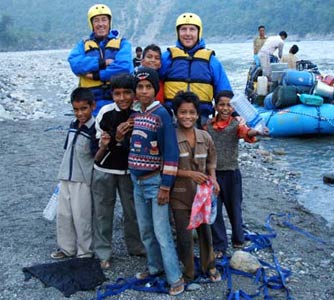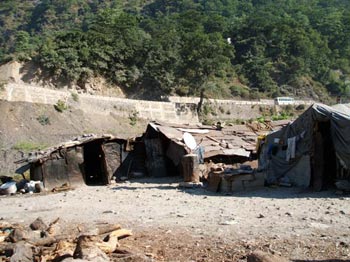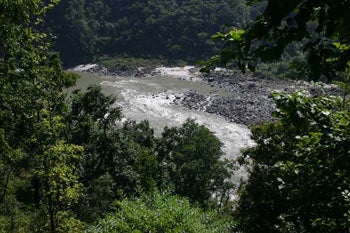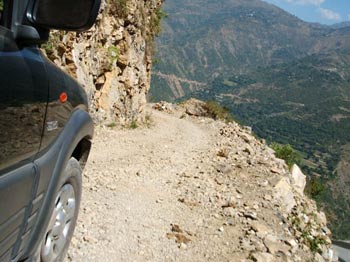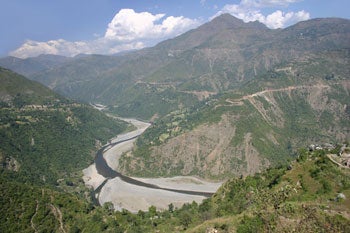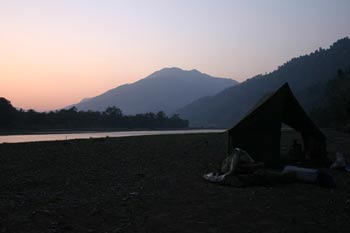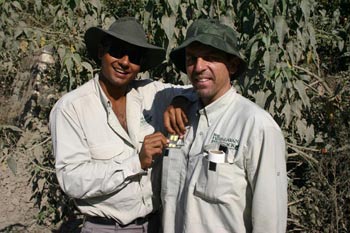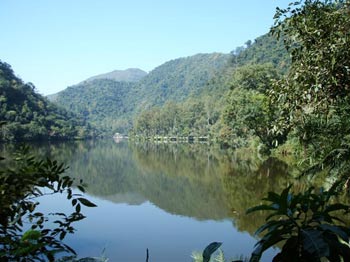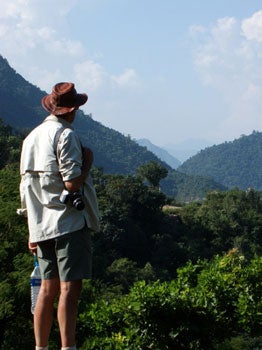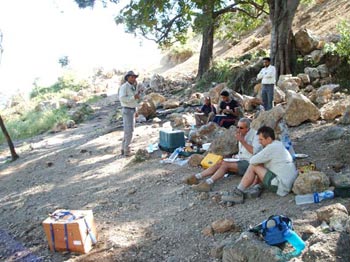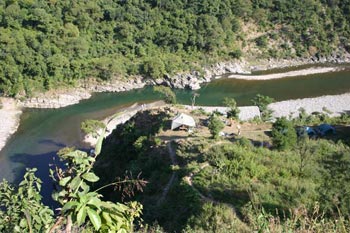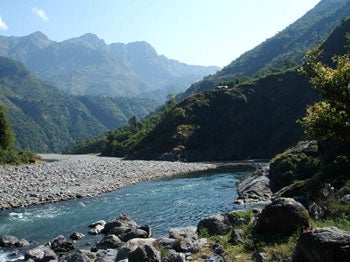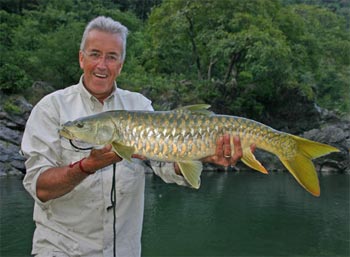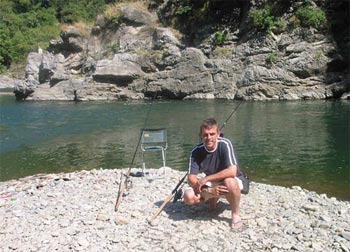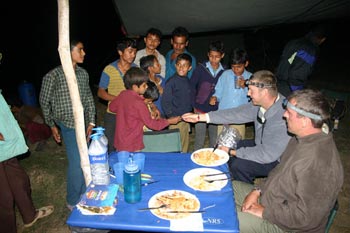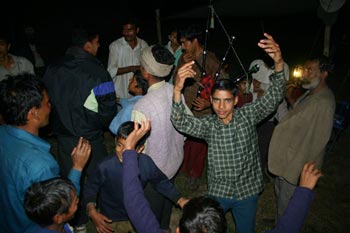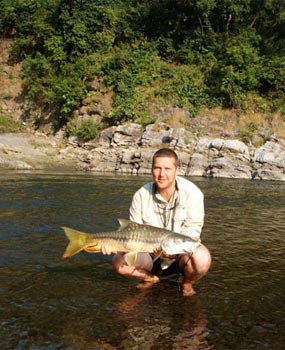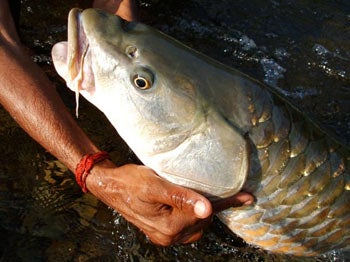Packing AwayIt was first light when we emerged from our tents at Byas Ghat. We had a long day of travelling ahead of us, to a river that couldn’t be more different from the Ganges, the banks of which had been our home for the last four days. Four days that had produced just two Golden Mahseer between three of us. Our appetite was whetted though, we were up for this! Whoever devised the saying ‘It ain’t half hot Mum!’ hasn’t been to Byas Ghat at sunrise in October. It most certainly wasn’t hot. In fact, It was bloody freezing! The Himalayan Outback team did all the packing while we huddled around the remnants of the previous night’s fire, trying to get some warmth back into our bones.
Rafts away! We were soon into the rafts and away on the next leg of our journey. We rounded the first bend and were met with an incredible sight. What we’d thought was a fire burning in the distance was in fact an ongoing landslide. We carefully steered over to the other side of the river to watch the spectacle in safety as we drifted past. A mixture of small stones and huge rocks rolled down the mountain. You could feel the vibrations, and the sound of perhaps half ton rocks hitting the river having started rolling a thousand feet up was something else! Unfortunately, the cameras were stowed away in the dry sack so we couldn’t take any pictures. It was a perfect reminder though, of exactly how wild and dangerous this land can be. It took one and a half hours to reach the outskirts of Rishikesh, where the rafting ended for the trip. It took an hour or so to offload all the gear onto the waiting 4 x 4’s during which time we had breakfast, and wandered around a small shanty village nearby. It was amusing to see a shack made from corrugated iron where a family lived. That’s not amusing in itself, but when there is a satellite dish stuck to the makeshift roof!! You do wonder about people’s priorities sometimes.
Back on the road Eventually we were away. We followed our original tracks along the Ganges for a while and picked up a takeaway lunch. More of this later!! We then turned west onto flatter terrain heading towards Dehra Dun. Dehra is the capital of the state of Uttranchal (formerly Northern Uttar Pradesh). Population 600,000, It’s a typical small Indian city; streets clogged with traffic of all descriptions, horns blaring and crazy overtaking manoeuvres. We went past a rather smart military academy, which was built by the British. There is a ‘no horn zone’ outside the academy, perhaps reflecting the British love of peace and quiet. You certainly don’t get any of that on most Indian roads! Through Dehra Dun there were more flat roads. Apart from Jackals regularly crossing the road there wasn’t much to see. It’s different in the hot season though, when Elephants often decide to lie down in the middle of the road, closing it for hours on end. After 3 hours or so we reached the border crossing to the state of Himachal Pradesh. We waited in the truck for 15 minutes while our driver spoke to the officials there, who were eyeing us suspiciously. Apparently no bribes were paid this time, although this is not always the case. A fair bit of banter was flying around the truck. Would they let us through? Were we seen as western intelligence? We wondered. Bob suggested that one look at us would be enough to knock that theory on the head. Reckon Bob was spot on there!!
Back in the mountains We then started climbing into the Himalayas again. There were no wide, busy roads this time. We were on a mixture of part made roads and dirt tracks, often little wider than our vehicle. This was seriously scary for someone not brilliant with heights. Actually, I was grateful that Stu took pity and swapped with me so I sat on the side of the truck away from the thousand feet sheer drop offs. Otherwise, Bob’s assertion that I wouldn’t need to bring many clothes (and for the purpose of what I’m talking about now: underpants) might have been a bit wide of the mark…. Anyway, after several hours of bumping and grinding along in this picturesque hell, the mountains opened up and we dropped into the Yammuna Valley. And what a spectacular valley, so different from the Ganges. While the latter was big and murky and powerful, this tributary of the Yammuna was green/ blue, winding it’s way through a wide flood plain of pure white sand. A small river in Indian terms, perhaps 20 yards wide.
Overnight camp It took a further hour of tortuous descent to reach the hydro-electric plant, beyond which, on a beach half a mile downstream, we made camp for the night. Actually, to be more accurate, Misty’s team made camp while we paddled up the lake downstream of the electric plant. We had permission to fish from the concrete walls of the plant right into the run off’s from the turbines. Not pretty this, but it was obvious from various large swirls that some large Mahseer find this area to their liking. Fish to 50 pounds have been taken from here in the past.
The fish didn’t want to know our plugs. We tried floaters, sinkers, joined, they just weren’t interested. Repeated casting into the dark within an ugly electricity plant soon became dull. Misty lent me his fly rod. Within seconds of one of his black creations on a size 10 hitting the water I had a pluck, which I missed, followed by several others. Eventually I hit into a small Mahseer, weighing less than a pound. It didn’t half fight though, as did a slightly larger one a few minutes later. They weren’t as acrobatic as a Trout but made up for it with strength, power and sheer guts. These fish just don’t give in! The guides brought us dinner while we fished. It was then that I started feeling a bit queasy. I didn’t eat much, I was very relieved to get back to the tent and get my head down for the night. Although it wasn’t for the night, as various bodily eruptions had me running backwards and forwards to the toilet tent. ‘Delhi Belly’ had struck!
A tough decision I felt pretty rough the following morning; ‘Delhi Belly’ had knocked me for six. Walking was a real effort. Not great timing this, we had more travelling ahead of us in the jeep, followed by a 2-hour trek to the river. I could either go along with the party or they would drop me at a local hotel. As tempting as a room sounded, and believe me, the fact that it would probably be riddled with bed bugs mattered not one bit; there wasn’t a choice to make really. You don’t fly a third of the way round the world to have the trip ruined by a bug. So, I dosed up on immodium and dragged myself to the waiting jeep. Religious sanctuary Just a mile or two from our overnight camp was a religious sanctuary. All animals are sacred in the Hindu religion, even Fish. The lake there was stuffed full of Mahseer from a couple of pounds upwards, to perhaps 30. They were so tame they would literally crawl over each other to get at the dough that we fed them with. All of us got a soaking from their antics. Stu got rather more, as A Goonch Catfish got in on the act and bit him on the finger. The ‘Devil Fish’ as they are known, they are a truly ghastly species; quite why Stu and Bob had brought tackle to catch them was beyond me. I decided not to walk round the lake as I felt too ill, I’d put my head down in the truck for an hour or so. On the way back I felt a whack from behind. My camera fell to the floor and was pounced on by the biggest Monkey we’d seen. It dropped the camera and bared its teeth to me. That was, until an onlooker grabbed a half brick and came within inches of ending its life. Animals are sacred, but Monkeys less so apparently!
It wasn’t a difficult trek down to the tributary. That is, if you’re reasonably fit. I wasn’t that day. After the longest 2 hours of my life I fell exhausted at our final camp of the trip. I only moved to get into my sleeping bag and there I stayed for the best part of a day.
This tributary of the Yammuna is quite an intimate river, certainly by Indian standards. It’s a succession of riffles and pools, crystal clear throughout. There were perhaps 40 or so Mahseer in the stretch. You could see them, and any early thoughts that this was going to be easy were soon dispelled as we saw their reaction to us. A fly line in the water had the entire population of one pool leave for the next one downstream. Our tactic on the Ganges i.e. fishing lures during the day was clearly not going to work here. OK, it might be different in the dark, but thrashing the water to a foam with big Rapalas was only going to make these fish impossible to catch. We all agreed that a cautious, natural bait approach would give us the best chance of catching. But what bait was available? ‘Action man’ Stu set off upriver. An hour later, and another bitten finger, he came back with a single Crab.
As Stu and I had caught on the Ganges, it was fitting that Bob caught the first fish on the tributary. The mid-double took Stu’s Crab with Bob in charge of the rod. Our camp was on a cliff above the river, directly behind where Bob hooked the Fish. Stu was watching from above and saw the Mahseer flash as it took the Crab, a split second before Bob nearly had the rod pulled out of his hands. Amazing stuff!! This was a fantastic looking fish, Bob was over the moon. This trip wasn’t all about catching fish, but it’s a long way to go to blank…
Frustration Stu didn’t fancy any more Crab bites (neither did Bob or I), We secured a supply of Maize from the local village though, and the Mahseer did eat it. On more than one occasion, while sat in camp, we could see them flashing over the freebies, seemingly feeding hard. As soon as you tried to catch them though they would vanish, and rarely returned. These fish were seriously spooky. Imagine a Chub with heightened senses.. And so, we didn’t hook another fish between us on natural baits.
Party party We were eating dinner on the final evening when we heard this strange wailing sound in the distance. It got closer, we could then see several lights moving in our direction. Then they came into view, half the population of the local village had come to ‘serenade’ us. In the lead was a wizened old chap carrying a set of bagpipes. Others had flutes and various other instruments. They played their music for an hour or so before leaving from where they came. It was a brilliant spectacle, and we felt honoured to be given this special treatment. It’s just a pity that the female half of the population stayed at home!
Last knockings Stu was rewarded for his perseverance with another mid-double, having gone out at midnight to cast a few lures about on the last night. A strange looking fish with a slight humped back. A well deserved fish though. The final morning dawned clear and bright as we trekked back to the road. It was easier this time, even though it was all uphill!
Himalayan Outback These days, with everyone’s obsession with profit, ‘great customer service’ is a bit of a clich When you purchase through links on our site, we may earn an affiliate commission, which supports our community.
|
Welcome!Log into your account










